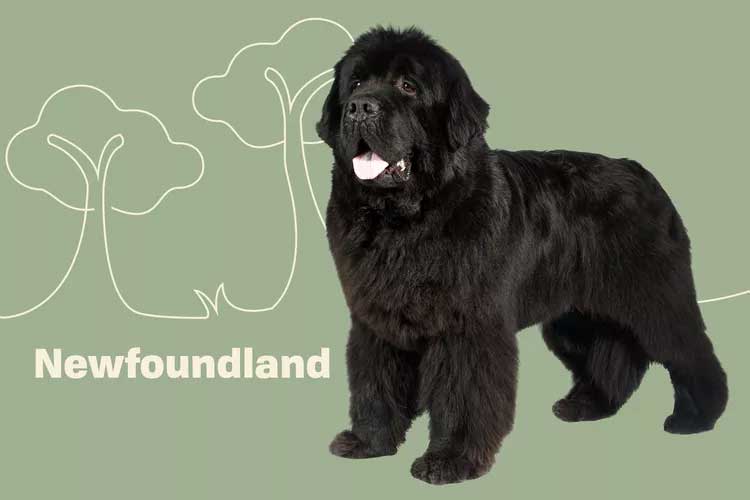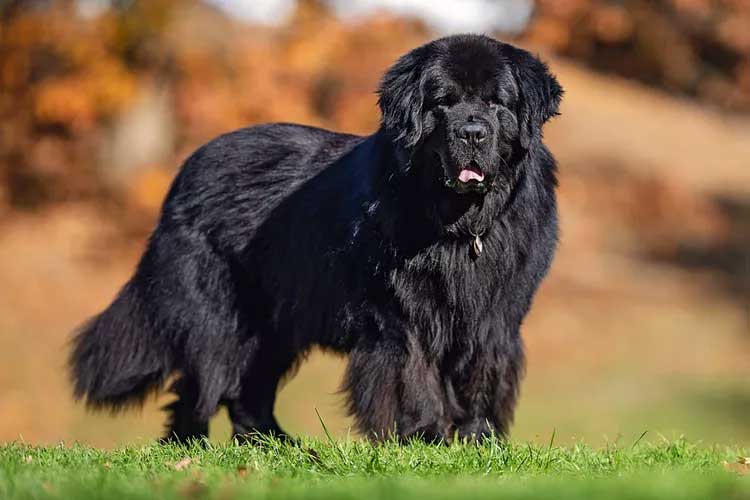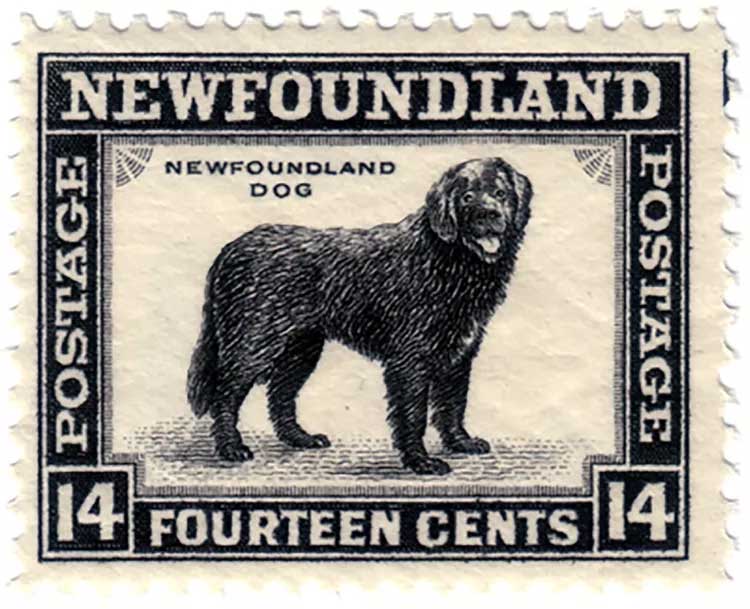Few dogs fit the description of majestic but gentle giants as well as the loving, sweet, and mild-tempered Newfoundland. Easygoing with children and loyal to their families, they’re devoted pets you’ll want to learn more about.

Newfoundland Overview
| OFFICIAL NAME | Newfoundland |
| COMMON NAME | Newfoundland |
| PET HEIGHT | 26 to 28 inches |
| PET WEIGHT | 100 to 150 pounds |
| LIFESPAN | 8 to 10 years |
| GOOD WITH | cats, children, dogs, families, seniors |
| TEMPERAMENT | friendly, gentle, playful |
| INTELLIGENCE | high |
| SHEDDING AMOUNT | normal |
| EXERCISE NEEDS | medium |
| ENERGY LEVEL | calm |
| VOCAL LEVEL | infrequent |
| DROOL AMOUNT | high |
| BREED GROUP | working |
| BREED SIZE | extra large (101 lbs. or more) |
| COAT LENGTH | long |
| COLORS | black, brown / chocolate / liver, gray |
| OTHER TRAITS | cold weather tolerant, easy to train, good for first-time pet owners, good hiking companion, highly territorial, high potential for weight gain, loves water, low prey drive, prone to health issues, requires lots of grooming, strong loyalty tendencies, tendency to chew |
Newfoundland owners often post photos of their dogs walking shoulder-to-shoulder with Shetland ponies, or standing upright against them with the caption, "Is this a bear? No, just my Newfoundland!" There's no denying they're massive dogs. A child could get lost cuddled up in their thick, heavy coats. The biggest Newfoundland dogs weigh more than an astonishing 200 pounds, though most are about half that size.
Equally at home on land and in the water, these sweet giants are terrific family pets if you have space for them. "Despite their size, [Newfoundlands] are extremely mellow dogs who don't require a lot of exercise," says Brita Kiffney, DVM, DABVP, of Northshore Veterinary Hospital in Bellingham, Wash., and outreach chair of the American Board of Veterinary Practitioners. But you'll need a bucket to catch all the drool!
Their gentle spirits make them fine, tolerant playmates for children, but behind their soulful eyes is the mind of a keen watchdog who looks out for her beloved family.
Appearance
Frequently featured on lists of the largest dog breeds, Newfoundlands (also lovingly called "Newfs" or "Newfies") are strong, big-boned, and muscular, their enormous heads resting near an adult's hip or higher for easy petting. Averaging 26–28 inches tall at the withers, most of their height comes from the rise of their deep chests and broad backs from stout-but-powerful legs. They weigh 100–150 pounds.
Kiffney says Newfs have "lovely double-hair coats that allow them to tolerate cold weather and, perhaps not intuitively, warmer weather as well." A flat coarse exterior helps insulate these avid swimmers from chilly water, while their undercoat is more plush. Common coat colors include black—maybe with a thin white tuft on the chin—chocolate brown, and gray. A more rare pattern in the United States is black and white.
While all dogs have a little bit of membrane between their toe pads, Newfoundlands actually have quite pronounced webbed feet to help them paddle easily through the surf.
The woe-be-gone gaze of a Newfoundland is due to deep, droopy eyes, usually dark brown, set above a deep, wide muzzle. A devoted expression invites you to reach out frequently to stroke her long, soft ears.
Temperament
Few dogs are as sweet, loyal, and laid-back as a mature Newfoundland. They take a lot of things in stride—being straddled by children, a hubbub of activity in the family room, persistent cats, and other dogs trying to be friends. Most of the time, the dog is content to nap while life buzzes all around her. Friendly and affectionate, but not overly rambunctious, she often likes to be "on" her people, leaning against them or lying across their feet. Yes, that includes babies.
Don't mistake this mellow vibe as laziness. Newfoundlands are people pleasers and natural working dogs. They expect you to tell them what needs to be done and love to be of service. In their native Newfoundland, Canada, they help retrieve fishermen's nets, perform water rescues, haul carts of wood, and do other similar chores, according to the Newfoundland Club of America (NCA). They have high IQs and respond well to positive reinforcement, clear cues, and obedience training.
While you'll sometimes hear a rumbling woof or two during playtime or to get your attention at dinner, a well-trained Newfoundland is a sentry. She only truly barks as a warning to alert you and anyone approaching that she's on duty to watch over her home.
When a dog is expected to grow almost as large as some of her owners, obedience, leash, and crate training are mandatory. Begin training and socialization as soon as you bring your puppy home. Newfoundlands have a prolonged adolescence state of up to two years, so giving them obedience guidance right way enables better socializing and deters undesirable behaviors such as nuisance chewing, jumping, and boredom barking.

Early socializing and training also helps ensure your Newfoundland pup plays safely with children. Because she'll gain almost 100 pounds in her first year, she might not realize in her youthful boisterousness that affectionately sitting on a child might be a bad thing! Proper cues and positive commands reinforce good behavior.
If you decide to take in a Newfoundland rescue, consult with a trainer who specializes in large dogs to help ease the transition into your family.
Living Needs
Whether you bring a Newfoundland into your apartment is totally dependent on how much room you want for yourself! So in most instances, she's much better suited to a home where there are cozy observing-the-world spots, as well as ample space for walks or galloping after family members.Kiffney says Newfs need a moderate amount of exercise—up to 30 minutes daily—and are happy to take walks, not runs, with their owners. Because a Newfoundland's temperament is so easy-going, she fits right in with a retiree's way of life, especially if they're together a lot to enjoy leisurely strolls throughout the day. She'll sniff around during these outings and take the world at a slower pace, maybe breaking away for a frisky romp in the water if there happens to be a swimming spot.

Do you have to live near water to have Newfoundlands? No, but they sure love to swim, are built well for it, and it's easy exercise for their joints, so it helps keep their weight within healthy ranges. Because of their innate working-dog tendencies, they also enjoy easy trail hikes, and at the peak of health, often lead the way! As long as it's not too hot, exploring the great outdoors with your Newfoundland and looking for new adventures is a wonderful way to celebrate all she has to offer. Ask your veterinarian for specific exercise recommendations at each stage of life.
Even the most well-trained and mellow Newfoundland has trouble being crated all day or left outside away from her people. Although she might look like a giant furball curled up in a corner, she's engaged and observing her surroundings, and that's just how she likes it. After all, President James Buchanan's Newfoundland, Lara, was famous for lying on the floor with one eye open to keep an eye on proceedings.
As a considerate animal guardian, carefully evaluate your activities and schedule before bringing a Newfoundland home.
Care
Get ready to hone your styling skills, because a Newfoundland dog requires a lot of grooming!First, there's her double-hair coat. Kiffney says it benefits from being brushed regularly, and there's extensive shedding about twice a year to contend with as well. Known as a "blowing coat," she'll shed primarily in the fall and spring and will need to be brushed daily to control it.

Dead hair, fur clumps, burrs, wads of mud, twigs, a nest of chipmunks—there’s no telling what might be tangled in all that fur! So set up a routine brushing two or three times a week. The Northern Newfoundland Club offers a detailed grooming guide and suggests helpful tools, such as a long-toothed comb, a slicker brush for Newfoundland puppies and a pin brush for adults, and an undercoat rake.
Her thick tresses also need to be consistently washed. As a general rule, if she smells a little less-than-fresh, it's time for a bath. Also, gauge bath frequency based on outdoor romping habits and how much debris she's tracking indoors.
Your Newfoundland will also need regular nail clipping and ear cleaning, along with frequent dental care throughout the week. Your family vet will help you develop a schedule based on your Newf’s particular needs.
Be sure to always have a towel handy to soak up all the drool! Newfoundlands do it a lot, and there's really no way around it. It's usually more prevalent after they eat and drink, so just wipe their muzzles clean of slobber and give 'em a smooch. Some owners even outfit their dogs with bibs to catch the worst of the dribbles.
Health
"A Newfoundland dog's lifespan is shorter on average than smaller dogs. They typically live to 8–10 years," Kiffney says. But in that short time, they'll experience tremendous growth, which might create some specific problems. "They're prone to orthopedic diseases—such as hip and elbow dysplasia—some heart disease, and skin and eyelid problems," she adds.Hip and elbow dysplasia are often genetic deformities that cause severe pain and arthritis, even in young Newfs. For example, cartilage in the hip eventually deteriorates, rubbing bone on bone, or the hip socket and thigh bone don’t fit together; and since the elbow didn’t develop properly during gestation, it rarely can be corrected.
Because there's a potential for structural and joint problems, be diligent about helping your Newfoundland maintain a lean physique. Consult your vet for a staged-growth diet and exercise plan. Controlled feedings also help minimize bloating.
Kiffney referenced dilated cardiomyopathy—an enlarged heart condition—and subaortic stenosis—a gathering of abnormal tissue that obstructs how the heart pumps blood—as internal problems that can affect Newfoundlands.
While Newfoundlands tolerate warmer weather, they should never be left outside in it for extended periods. Their double coat makes it difficult to handle. The undercoat provides some ventilated cooling, but overall, they'll overheat quickly. If they have to be outside, provide a wading pool or a rotating sprinkler to help them chill out, but resist giving them ice cubes. Also, trim the outer coat to provide extra summertime comfort.
The Newfoundland Club of America provides an extensive database of health information to help you understand what questions to ask a breeder, your vet, and trainers about how to create the best life for your Newfoundland.

History
Newfoundlands, native to the Canadian province of the same name, come by their love of water naturally. Some breed historians suggest European fishermen bred their own dogs, perhaps a Great Pyrenees, with the Newfoundland's ancestors. Though their exact origins are unknown, according to the Heart of America Newfoundland Club (HANC), it's generally accepted that Newfies are a native North American breed, perhaps developed by the Algonquin and Sioux peoples.Newfies were named in 1775 by trader George Cartwright. Bred to work, they were used to haul fishermen's nets, cart wood through the ports, and served as water rescue dogs, according to the HANC.
Newfoundlands have an exceptional swimming ability—they actually do a breaststroke, rather than a doggie paddle. This enables these brave lifesavers to retrieve a drowning person and tow them back to shore by the arm, face up, so they can breathe. Newfoundlands were once required companions for lifeguards scanning the shores of England and Wales.
Fun Facts
Seaman was a Newfoundland traveler with Lewis and Clark as they traversed America’s untamed lands between 1803 and 1806.Another notable pooch is the black-and-white Newfoundland known as the Landseer variety, named in honor of artist Sir Edwin Landseer, who celebrated this now rare color pattern of the breed in classic paintings such as A Distinguished Member of the Humane Society.
In another case of life imitating art, author J.M. Barrie was such a fan of the Newfoundland, Luath, he had as a pet that in his original play for Peter Pan, the Darling children had Nana, a nurse dog of the same breed. However, in the many screen adaptations of the story, Nana is portrayed by either a Saint Bernard or an English sheepdog. Other literary Newfoundland owners included poets Emily Dickinson and Lord Byron. Byron’s poem Epitaph to a Dog was written to honor his late Newfoundland, Boatswain.
Movie-lovers might also remember the adorable Newfoundland Mother Theresa, who actors Diane Lane and John Cusack fawned over in the 2005 romantic comedy Must Love Dogs.
A few Newfies have even rested their massive heads on the floors of the White House as companions of presidents Ulysses S. Grant, Rutherford B. Hayes, Buchanan, and James A. Garfield.